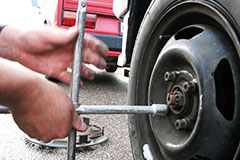How to Change a Car Tire - Vol.309
It is essential to know how to change your car's tire in case of breakdown or emergency. Most vehicles are equipped with a spare tire and the basic set of tools needed to change the tire yourself, and the locations of these items can be found in your owner's manual. It is unsafe to drive any vehicle with a flat tire, as this can cause expensive damage to the rim and axle. There are signs of a flat tire including notifications of modern tire pressure monitoring systems (tpms) and warning lights, as well as noises coming from the tires, an abnormally bumpy ride, and the steering wheel pulling in one direction. It is best to pull over in a safe place, away from traffic, and check each tire if you suspect one is losing pressure or has gone flat.

How to Know When a Tire Should be Changed & Being Prepared
To confirm if the tire has low pressure you should keep a tire pressure gauge in your vehicle, which can be purchased at many gas stations or car parts stores. The specific pressure for your vehicle's tires can be found in the owner's manual, but most are between 32 and 35 pounds per square inch (psi). If the tire pressure is below the recommendations, and there is no visible damage or puncture, you can first attempt to fill your tire with air at many gas or way stations and continue to check for further loss of pressure. If you determine the car is losing pressure or has any visible damage, then follow these directions to temporarily put on the spare tire. You will need the following items; spare tire designed for your vehicle, a vehicle jack, and a tire wrench. All of these should be located in the rear compartment of the vehicle, but be sure to check before long trips. You may also want to keep a pair of work gloves, a bright traffic vest, warning triangle or flares, and something for padding on the ground while you work.
Removing the Flat & Attaching the Spare
Once your vehicle is parked in a safe place, you are away from any dangers of traffic, and you have located the necessary items you can begin to change the tire. If your vehicle becomes disabled in the lane of travel or on a narrow shoulder it is best to warn on coming traffic with flares or warning triangles and to notify police. Do not attempt to change the tire and exit the vehicle when it is safe to do so and stand away from traffic. The vehicle jack allows you to lift the vehicle off the ground enough to remove the tire and replace it with the spare, but under no circumstances should you use it to prop the vehicle while you are underneath it. Most vehicles have a screw jack, which extends and retracts by twisting the screw. Often the tire wrench is designed to also serve as the mechanism to extend and retract the jack, consult the owner's manual if you are unsure. Extend the vehicle jack until it is about an inch shorter than the frame of the car, then place it underneath and raise it so the jack comes into contact with a solid portion of the car's frame near the tire that needs replacing. Continue to raise the jack until it lifts the corner of the vehicle approximately 1-2 inches from the ground. You may need to remove the hubcap, in order to see the lug nuts that attach the rim of the tire to the wheel. Use the tire wrench to loosen each lug nut, then remove each of them while supporting the weight of the tire. Once these are removed the tire should come off and the spare tire can be put on in its place. Reattach the lug nuts and tighten with your hand at first, then use the tire wrench to finish tightening each of them. Once the spare is secure, lower and remove the jack and place everything back in the vehicle including the tire and rim. Once the spare tire, or donut, is secure on the rim it is only safe to drive the vehicle for a short period of time at speeds no faster than 50 MPH (80KMH). The spare is only intended to allow transportation of the vehicle long enough to reach a mechanic or be replaced with a full size tire. Replacing a full size car tire follows a similar process as putting on the spare, but should be done with a hydraulic tool to ensure it is securely fastened.